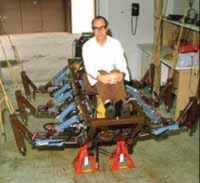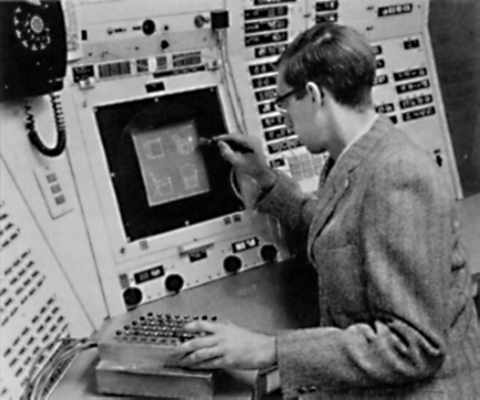| Ivan Sutherland - Father of Computer Graphics |
| Written by Historian | |||||||
Page 3 of 3
Evans And SutherlandIn 1968 Sutherland moved to At about the same time they also set up “Evans and Sutherland” to build real time graphics based simulators and other graphics products. Evans and Sutherland is still the world leader in providing flying simulators for pilot training shipping equipment worth $150 million. As you might guess much of the work of Evans and Sutherland is for the military and hence not on public display. The early virtual reality work had made Sutherland think about the problems of 3D representations and he invented both the viewport clipping algorithm and the practical perspective projection algorithm. He also started the subject of hidden surface removal. When you draw a 3D scene you have to decide which surfaces of the wire frame object are hidden by surfaces closer to the viewpoint. Hidden surface removal was the last work that Sutherland did in graphics. When he wrote the paper “A characterization of ten hidden surface algorithms” with Bob Sproull and Bob Schumacker he realized that all hidden surface algorithms were variations on sorting and gave up graphics.
Sutherland received the Turing Awarded in 1988 for the invention of Sketchpad and is considered by many to be the father of computer graphics. However he has many other claims to fame and he has done so many and various things that it is difficult to see where he managed to get the time from. During 1976-1980 he helped Carver Mead introduce the construction of integrated circuit design to the universities. Until then it had been the almost exclusive preserve of a few large companies and academics found it too mundane to study. Sutherland and Mead founded a Computer Science Department at Caltech focused on integrated circuit design. By teaching integrated circuit design they helped ensure that In the 1980s he started what he most probably thinks of as his most “fun” project – a six-legged walking machine. It was large enough to have a cockpit for a human pilot and Ivan’s brother, by this time a former Navy pilot, provided the joystick. It was an exercise in hydraulics and control but it also proved a theoretical point – due to inertial forces and momentum six legs work well on small things but for man-sized machines two legs are better. Nevertheless the machine, called the Trojan Cockroach, did walk and it even made it to the cover of Scientific American in January 1983. The Trojan Cockroach In 1980 together with Bob Sproull, he also formed Sutherland, Sproull & Associates and Ivan’s brother Bert joined them two years later. In 1990 Sun bought the company for its patents and people and they became the core of Sun Microsystems Laboratories. Sutherland remained as a Vice President and Fellow at Sun Microsystems until 2009. More recently he has been leading the research in Asynchronous Systems, i.e. computers without a central clock to slow them down to the slowest component, at Portland State University where he founded Asynchronous Research Center (ARC) as a Visiting Scientist. Sutherland currently combines his post at Portland State University with consulting work for the U.S. Government and firms like Oracle Laboratory and ForrestHunt. His influence has spanned academia and industry. He holds over 60 patents, and some of his students have gone on to found important companies. Commenting on his brilliant students, Sutherland stated in 2019, when he was awarded the BBVA Frontiers in Knowledge Award: "Their excellence enabled several of them to be involved in entrepreneurial companies, some of which did marvelous things. For instance, Edwin Catmull started Pixar, which makes very entertaining films. And John Warnock was one of the founders of Adobe. I am pleased to have known those people and made some small contribution to their education." Despite the diversity of subjects that Sutherland has worked on over the years they all seem to have been driven by a desire to enjoy the intellectual endeavour and basically have fun. As he put it himself in 1991, “I, for one, am and always will remain a practising technologist. When denied my minimum daily adult dose of technology, I get grouchy. I believe that technology is fun, especially when computers are involved, a sort of grand game or puzzle with ever so neat parts to fit together. I have turned down several lucrative administrative jobs because they would deny me that fun. If the technology you do isn’t fun for you, you may wish to seek other employment. Without the fun, none of us would go on.” In 2012 Sutherland was awarded the Kyoto Prize in Advanced Technology by the Inamori Foundation. In its announcement the Inamori Foundation stated: Numerous computer graphic-based applications -- ranging from films, games and virtual reality systems to educational materials, scientific and technological simulations, and other design aids for engineers -- are descendants of Dr. Sutherland's original work on Sketchpad. In 2019 he was the recipient of Frontiers of Knowledge Award from the BBVA as announced in this video. In Spanish it combines archive footage with Sutherland talking to camera in English, but with Spanish voice-over that tends to drown it out, about his life's work: The citation from the BBVA was: Over the course of his 60-year career, the American computer scientist has led the transition from text-based to graphical computer displays. He pioneered the use of graphical icons and virtual reality, and anyone who uses a computer or smartphone today benefits from the output of his research. Sutherland admits in the video that he he had been unaware of the eventual implications of his work with Sketchpad: “I had no idea what it would lead to. I did it because it was interesting to do. I was given access to a computer. I wanted to make drawings on that computer, because I liked drawings, and I liked to make them neat, and the computer delivered that. I did what I did because each step was interesting and technically possible, and clearly gave us access to information in a new way that would obviously be useful, even if how it would be used was not clear.” His comments on the future depending on the curiosity of young people also reflect his attitude as a groundbreaking pioneer: “Young people are wonderful. They don’t know what they can’t do, so they go ahead and do it.”
To be informed about new articles on I Programmer, sign up for our weekly newsletter, subscribe to the RSS feed and follow us on Twitter, Facebook or Linkedin.
Comments
or email your comment to: comments@i-programmer.info
<ASIN:0812219236> <ASIN:1846280346> |
|||||||
| Last Updated ( Thursday, 28 February 2019 ) |




